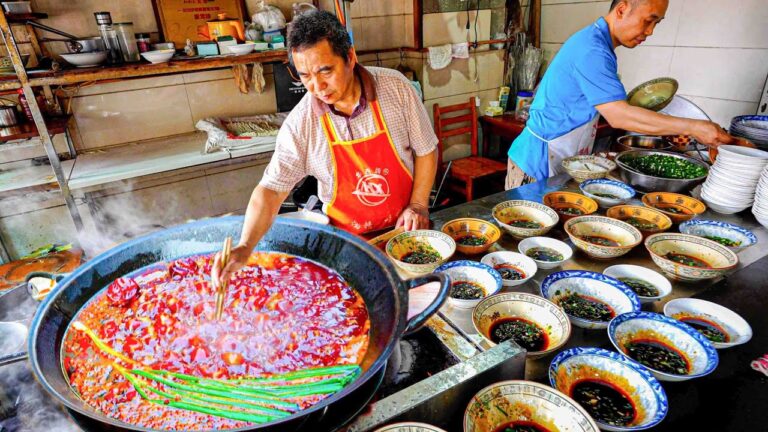Chinese food is one of the most beloved and diverse cuisines in the world. From its ancient roots to its contemporary adaptations, it has captivated the hearts and taste buds of millions. This article will explore the origins, evolution, and key characteristics of Chinese food. Additionally, we will dive into popular dishes, cooking techniques, and cultural influences that make Chinese food an essential part of global culinary traditions.
The Rich History of Chinese Cuisine
Chinese food has a long and storied history that spans thousands of years. Ancient Chinese culinary practices were shaped by geographical regions, agricultural advancements, and the country’s cultural values.
The Four Major Regional Cuisines
China’s vast territory has given rise to distinct regional cuisines. While there are many local variations, four major styles dominate Chinese food:
-
Cantonese Cuisine – Originating from Guangdong province, Cantonese food is characterized by fresh ingredients, light flavors, and an emphasis on seafood. Dishes like dim sum and sweet and sour pork are popular globally.
-
Sichuan Cuisine – Known for its bold, spicy flavors, Sichuan cuisine features ingredients like chili peppers, garlic, and the numbing taste of Sichuan peppercorns. Mapo tofu and Kung Pao chicken are signature dishes from this region.
-
Shandong Cuisine – This northern cuisine uses rich flavors, with an emphasis on seafood, soups, and noodles. It’s known for dishes like Peking duck and jiaozi (dumplings).
-
Jiangsu Cuisine – Known for its use of freshwater fish and delicate flavors, Jiangsu food includes dishes like sweet and sour spare ribs and braised pork.
These regional styles combine to offer a truly diverse array of flavors and textures that form the backbone of Chinese cuisine.
Key Ingredients in Chinese Food
Chinese food is all about balance. The art of combining ingredients to create harmony between flavors, textures, and colors is what makes it so special. Some common ingredients you will encounter in Chinese dishes include:
-
Soy Sauce: A staple in Chinese cooking, soy sauce adds a savory, umami flavor to dishes. It’s used in marinades, stir-fries, and sauces.
-
Ginger and Garlic: These aromatic ingredients form the base of many Chinese sauces and stir-fries, lending a robust flavor and fragrance.
-
Rice and Noodles: Rice is a core part of Chinese meals, while noodles are often used in soups, stir-fries, and salads.
-
Tofu: Tofu, made from soybeans, is an essential protein source in Chinese food, particularly in vegetarian dishes.
-
Vegetables: Chinese cuisine incorporates a wide variety of vegetables, such as bok choy, Chinese cabbage, mushrooms, and snow peas.
-
Five Spice Powder: A blend of cinnamon, star anise, fennel seeds, Sichuan peppercorns, and cloves, this aromatic spice is a hallmark of Chinese dishes.
Exploring Popular Chinese Dishes
Chinese cuisine is incredibly diverse, offering a wide range of dishes that cater to different tastes. Here are some of the most popular Chinese dishes enjoyed around the world.
1. Sweet and Sour Pork
A quintessential Cantonese dish, sweet and sour pork features crispy pieces of pork battered and deep-fried, coated in a tangy, bright sauce made from vinegar, sugar, and ketchup. This dish is a perfect balance of flavors—sweet, sour, and savory.
2. Kung Pao Chicken
Originating from Sichuan, Kung Pao chicken is a stir-fry dish made with chicken, peanuts, and vegetables, all coated in a spicy, tangy sauce. The dish is renowned for its perfect balance of salty, sweet, and spicy flavors.
3. Peking Duck
One of the most famous dishes in Chinese cuisine, Peking duck is a flavorful, crispy-skinned duck served with thin pancakes, hoisin sauce, and sliced vegetables. This dish dates back to the Ming Dynasty and is a must-try for anyone who enjoys Chinese food.
4. Mapo Tofu
This Sichuan dish combines soft tofu with ground pork in a spicy, savory sauce made from chili paste, Sichuan peppercorns, and fermented bean paste. The heat from the chilies is balanced by the soft texture of the tofu, making this a unique and flavorful dish.
5. Dim Sum
Dim sum refers to a variety of bite-sized dishes traditionally served with tea. These can include dumplings, buns, rolls, and other treats. Popular dim sum items include steamed dumplings (xiao long bao) and crispy spring rolls.
6. Chow Mein
Chow Mein is a stir-fried noodle dish commonly found in Chinese restaurants worldwide. The dish typically includes vegetables, chicken, beef, or shrimp, all tossed with thin noodles in a savory sauce.
Chinese Food for Special Occasions
In Chinese culture, food plays an important role in festivals and celebrations. For instance:
-
Chinese New Year: This is the most significant holiday in China, and food is an integral part of the celebrations. Dishes like dumplings (symbolizing wealth), fish (representing abundance), and Nian Gao (rice cake) are commonly served to bring good fortune in the year ahead.
-
Mid-Autumn Festival: During this festival, mooncakes—round pastries filled with sweet or savory fillings—are enjoyed to celebrate the harvest and full moon.
-
Weddings: Traditional Chinese wedding banquets include a lavish spread of delicacies, including shark fin soup, roasted pig, and a variety of meat and seafood dishes.
Cooking Techniques in Chinese Cuisine
Chinese cooking techniques are diverse and often center around achieving perfect textures and flavors. Common cooking methods include:
Stir-Frying
One of the most popular cooking techniques, stir-frying involves cooking ingredients quickly over high heat in a wok with a small amount of oil. This method is ideal for preserving the color, flavor, and texture of vegetables and meats.
Steaming
Steaming is a healthier cooking method often used in Chinese food. It allows food to retain its natural flavors and nutrients. Dim sum, fish, and buns are often steamed to achieve a soft, delicate texture.
Braising
Braising involves cooking meat or vegetables slowly in a flavorful liquid. This method is perfect for tougher cuts of meat, such as pork belly, allowing them to become tender and absorb all the flavors from the sauce.
Deep-Frying
Although not as common as stir-frying or steaming, deep-frying is still an essential technique in Chinese cuisine. Dishes like sweet and sour pork, crispy duck, and spring rolls are deep-fried to achieve a crispy exterior.
The Health Benefits of Chinese Food
Many people associate Chinese food with unhealthy takeout options, but Chinese cuisine can actually be quite healthy. The use of fresh vegetables, lean meats, and tofu makes Chinese dishes rich in vitamins, minerals, and protein. Additionally, Chinese cooking techniques like steaming and stir-frying retain the nutrients in food better than methods such as deep-frying.
Nutrient-Rich Ingredients
-
Tofu: Rich in protein and low in fat, tofu is a great source of plant-based protein and can lower cholesterol.
-
Ginger: Known for its anti-inflammatory properties, ginger is often used in Chinese cooking to aid digestion and reduce nausea.
-
Garlic: Garlic has numerous health benefits, including boosting the immune system and reducing blood pressure.
-
Green Tea: Often served with Chinese meals, green tea is packed with antioxidants and is known for its metabolism-boosting properties.
Balancing Flavors and Nutrients
Chinese cuisine excels in balancing different tastes—sweet, sour, salty, bitter, and umami—which not only makes food more enjoyable but also contributes to overall health. For instance, many dishes feature a combination of protein, vegetables, and healthy fats, providing a well-rounded meal.
The Influence of Chinese Food Around the World
Chinese food has transcended its native borders, becoming a global phenomenon. As Chinese communities settled across the world, they introduced their culinary traditions to new countries, where they were adapted to local tastes and ingredients. Today, Chinese food can be found on every continent, with Chinese restaurants serving everything from Americanized dishes like General Tso’s chicken to authentic Sichuan hot pots.
Chinese Food in the West
In Western countries, Chinese food has evolved into a style that’s distinct from traditional Chinese cuisine. Dishes like sweet and sour chicken, fortune cookies, and chop suey were all created to appeal to Western palates. Despite this, many Chinese communities continue to serve traditional dishes in their restaurants, preserving the rich heritage of Chinese cooking.
Chinese Food in Other Asian Countries
Chinese food has also been adapted by neighboring Asian countries, influencing and blending with local cuisines. In Thailand, for example, Chinese food has contributed to the development of Thai-Chinese dishes like crispy pork with basil and noodle soups. Similarly, in Malaysia, Chinese food plays a key role in the local food culture, with dishes like Hainanese chicken rice becoming a staple.
Conclusion
Chinese food is a complex and fascinating culinary tradition that offers a wide range of flavors, textures, and techniques. From its rich history to its widespread influence around the globe, Chinese cuisine has earned its place as one of the most cherished food cultures in the world. Whether you’re enjoying a bowl of noodles in Sichuan, dim sum in Hong Kong, or a plate of sweet and sour pork in New York, Chinese food continues to inspire and delight people worldwide.
If you’ve never explored Chinese food in-depth, now is the perfect time to start. Try a few recipes, explore new restaurants, and savor the rich flavors that define one of the world’s greatest cuisines.

